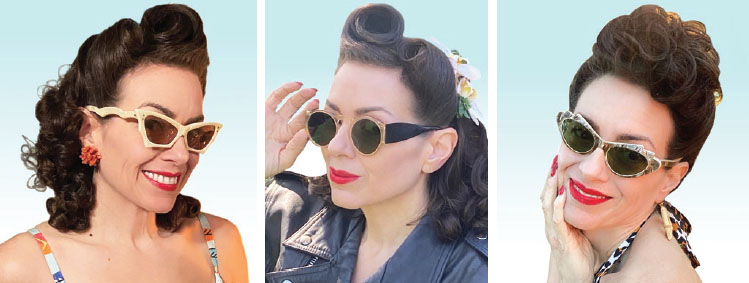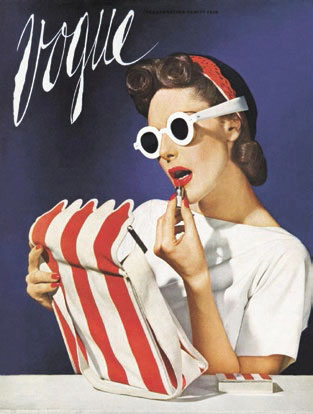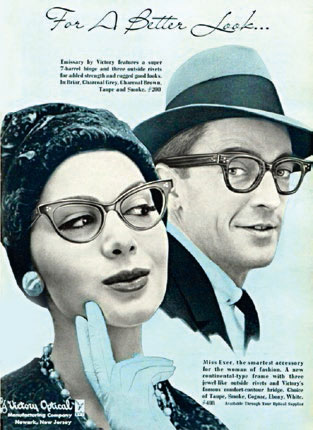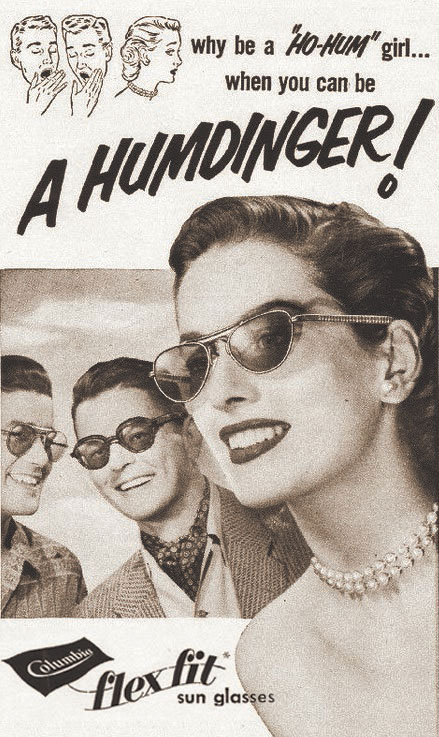Shades of Cool - Page 2
 |
|
|
One cool collector
Today, authentic vintage sunglasses are prized by collectors for their one-of-a-kind styles, jazzy jeweled insets, and eye-catching color combinations.
Fashion and sunglasses go hand in hand. For Marjorie VanderHoff, a Los Angeles-based costumer, choreographer, and vintage aficionado, "There's nothing like wearing the real thing." For her, it's a way of life.
VanderHoff's devotion to living an authentic vintage lifestyle extends to her period-perfect Art Deco home in Lake Balboa, where she enjoys displaying her carefully curated collection of eyewear that dates back to the 1930s.
"I'm a vintage girl all the way," she coos, modeling a pair of flirty '50s cat-eyes from her collection. "I wear vintage clothing every day, live in a vintage home, and drive a vintage car. And I wouldn't dream of living any other way."
During the summer, VanderHoff loves driving her 1951 Buick Super with all the windows down, her hair done up, wearing a vintage dress and—of course—vintage sunglasses. "I feel like a movie star. Everybody wants to talk to me. The car! That dress! Those cat-eye glasses!"
 |
Stars signal the craze
During the silent-movie days of 1920s Hollywood, movie stars, looking to shield their eyes from flashbulbs and glaring studio lights, began wearing protective eyewear. Though sunglasses had been worn for outdoor recreational activities like golf and tennis in the '20s, they still had not made their mark on the fashion world.
But, in the 1930s, as celebrities began to be seen wearing sunglasses on and off movie sets, and their photographs reached the pages of fan magazines, the public started to take note of stars' striking eyewear. Sunglasses were now viewed as a fun fashion accessory, ideally suited for leisure activities.
Seeing an opportunity, Sam Foster, who had been operating a plastics company on the East Coast since 1919, decided to try selling his own inexpensive celluloid-and-wire sunglasses at the Woolworth's store on the Atlantic City Boardwalk in New Jersey. That was in 1929.
Those glasses were an immediate hit with beach-goers; and Fosta-Grantly, as Foster's brand would be called, soon became the first company to launch the mass production of sunglasses in America.
By the mid-1930s, Sunglasses were commonly seen on the streets of both coasts, and on celebrities, including Marlene Dietrich, Bette Davis, and Joan Crawford. At the same time, fashion magazine Vogue began to shift gears with its approach to content, and in July 1939, with a striking, bold photograph, became one of the earliest fashion magazines to feature a model wearing sunglasses on its cover.
 |
 |
"Once fashion photography was deemed an art circa the mid-1930s," writes Vogue archive editor Laird Borrelli-Persson in 2017, "Vogue changed track and greeted its reader with stylized snaps of real-life beauties and professional models, and eventually began showcasing actors and entertainers."
Demand for sunglasses soon skyrocketed, with Life magazine reporting in 1938 that sunglasses were a "new fad for wear on city streets," while adding that, for the preceding year, "20 million pairs of sunglasses were sold, but only 25 percent wore them to protect their eyes."




